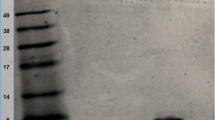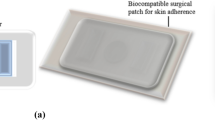Abstract
The present study deals with the formulation of topical insulin for wound healing with extended stability and sustained release, by applying quality by design concepts. Insulin has been promoted as a promising therapeutic wound healing agent. Topical formulation of insulin faced major problems, as it cannot be delivered safely to the wound with a controlled rate. Formulation of insulin-loaded vesicles in optimized bio-adhesive hydrogels has been explored to ensure a safe delivery of insulin to wounds in a controlled manner. Quality by design (QbD) was applied to study the effect of several critical process parameters on the critical quality attributes. Ishikawa diagram was used to identify the highest risk factors, which were screened by a fractional factorial design and augmented by Box–Behnken design. The optimized formula was incorporated into a mucoadhesive gel, which was further subjected to stability and clinical studies. An optimized formula was obtained with a particle size of 257.751 nm, zeta potential − 20.548 mv, 87.379% entrapment efficiency, and a release rate of 91.521 μg/cm2/h. The results showed that liposomal insulin remained stable for 6 months in aqueous dispersion state at 4°C. Moreover, the release was sustained up to 24 h. The clinical study showed an improvement in the wound healing rate, 16 times, as the control group, with magnificent reduction in the erythema of the ulcer and no signs of hypoglycemia. Insulin-loaded liposomal chitosan gel showed a promising drug delivery system with high stability and sustained release.









Similar content being viewed by others
References
Joseph B. Insulin in the treatment of non-diabetic bed sores. Ann Surg. 1930;92(2):318–9.
Liu Y, Petreaca M, Martins-Green M. Cell and molecular mechanisms of insulin-induced angiogenesis. J Cell Mol Med. 2009;13(11–12):4492–504.
Chen S, Singh J. Controlled release of growth hormone from thermosensitive triblock copolymer systems: in vitro and in vivo evaluation. Int J Pharm. 2008 [cited 2016 Aug 18];352(1):58–65.
Ulrich A. Biophysical aspects of using liposomes as delivery vehicles. Biosci Rep. 2002 [cited 2016 Aug 18];22(2):129–50.
Parente ME, Andrade AO, Ares G, Russo F. Bioadhesive hydrogels for cosmetic applications. Int J Cosmet Sci. 2015;37(5):511–8.
AbdelKader DH, Osman MA, Elgizaway SA, Faheem A, McCarron PA. The role of insulin in wound healing process : mechanism of action and pharmaceutical applications. J Anal Pharm Res. 2016;2(1).
Patwardhan K, Asgarzadeh F, Dassinger T, Albers J, Repka MA. A quality by design approach to understand formulation and process variability in pharmaceutical melt extrusion processes. J Pharm Pharmacol. 2015;67(5):673–84.
Yu LX. Pharmaceutical quality by design: product and process development, understanding, and control. Pharm Res. 2008;25(4):781–91.
Hülsermann U, Hoffmann M. Uptake of apolipoprotein E fragment coupled liposomes by cultured brain microvessel endothelial cells and intact brain capillaries. J drug drug Target. 2009;17(8):610–8.
Aboelwafa AA, El-Setouhy DA, Elmeshad AN. Comparative study on the effects of some polyoxyethylene alkyl ether and sorbitan fatty acid ester surfactants on the performance of transdermal carvedilol proniosomal gel using experimental design. AAPS PharmSciTech. 2010 Dec [cited 2013 Nov 28];11(4):1591–602.
Xu X, Khan MA, Burgess DJ. A quality by design (QbD) case study on liposomes containing hydrophilic API: I. Formulation, processing design and risk assessment. Int J Pharm. Elsevier B.V. 2011;419(1–2):52–9.
Sezer AD, Hatipoğlu F, Cevher E, Oğurtan Z, Baş AL, Akbuğa J. Chitosan film containing fucoidan as a wound dressing for dermal burn healing: preparation and in vitro/in vivo evaluation. AAPS PharmSciTech. 2007;8(2):Article 39.
Ranade S, Bajaj A, Londhe V, Babul N, Kao D. Fabrication of topical metered dose film forming sprays for pain management. Eur J Pharm Sci. 2017;100:132–41.
Pogány J. ICH pharmaceutical quality system Q10. WHO Drug Inf. 2008;22(3):177–81.
Matuszewska B, Keogan M, Fisher DM, Soper KA, Hoe CM, Huber AC, et al. Acidic fibroblast growth factor: evaluation of topical formulations in a diabetic mouse wound healing model. Pharm Res. 1994;11(1):65–71.
Elsner P, Wilhelm D, Maibach H. Multiple parameter assessment of vulvar irritant contact dermatitis. Contact Dermatitis. 1990;23(1):20–6.
Rezvani O, Shabbak E, Aslani A, Bidar R, Jafari M, Safarnezhad S. A randomized, double-blind, placebo-controlled trial to determine the effects of topical insulin on wound healing. Ostomy Wound Manage. 2009;55(8):22.
ICH Expert Working Group. Quality risk management Q9. In: ICH harmonised tripartite guideline. 2005. p. 1–23.
Shah B, Khunt D, Bhatt H, Misra M, Padh H. Application of quality by design approach for intranasal delivery of rivastigmine loaded solid lipid nanoparticles: effect on formulation and characterization parameters. Eur J Pharm Sci Elsevier BV. 2015;78:54–66.
Xu X, Costa AP, Khan MA, Burgess DJ. Application of quality by design to formulation and processing of protein liposomes. Int J Pharm Elsevier BV. 2012;434(1–2):349–59.
Maestrelli F, González-Rodríguez ML, Rabasco AM, Mura P. Effect of preparation technique on the properties of liposomes encapsulating ketoprofen-cyclodextrin complexes aimed for transdermal delivery. Int J Pharm. 2006;312(1–2):53–60.
Ahad A, Aqil M, Kohli K, Sultana Y, Mujeeb M, Ali A. Formulation and optimization of nanotransfersomes using experimental design technique for accentuated transdermal delivery of valsartan. Nanomedicine Elsevier Inc. 2012;8(2):237–49.
Li J, Wang X, Zhang T, Wang C, Huang Z, Luo X, et al. A review on phospholipids and their main applications in drug delivery systems. Asian J Pharm Sci Elsevier Ltd. 2014;10(2):81–98.
Xu X, Costa A, Burgess DJ. Protein encapsulation in unilamellar liposomes: high encapsulation efficiency and a novel technique to assess lipid-protein interaction. Pharm Res. 2012;29(7):1919–31.
Soema PC, Willems GJ, Jiskoot W, Amorij JP, Kersten GF. Predicting the influence of liposomal lipid composition on liposome size, zeta potential and liposome-induced dendritic cell maturation using a design of experiments approach. Eur J Pharm Biopharm Elsevier BV. 2015;94:427–35.
Tabbakhian M, Rogers JA. Interaction of insulin, cholesterol-derivatized mannan, and carboxymethyl chitin with liposomes: a differential scanning calorimetry study. Res Pharm Sci. 2012;7(1):43–50.
Liu DZ, Chen WY, Tasi LM, Yang SP. Microcalorimetric and shear studies on the effects of cholesterol on the physical stability of lipid vesicles. Colloids Surfaces A Physicochem Eng Asp. 2000;172(1–3):57–67.
Brange J, Langkjoer L. Insulin structure and stability. Pharm Biotechnol. 1993;5(1922):315–50.
Xia S, Xu S. Ferrous sulfate liposomes: preparation, stability and application in fluid milk. Food Res Int. 2005;38(3):289–96.
Zhang X, Qi J, Lu Y, Hu X, He W, Wu W. Enhanced hypoglycemic effect of biotin-modified liposomes loading insulin: effect of formulation variables, intracellular trafficking, and cytotoxicity. Nanoscale Res Lett. 2014;9(1):1–10.
Yang S, Chen J, Zhao D, Han D, Chen X. Comparative study on preparative methods of DC-Chol/DOPE liposomes and formulation optimization by determining encapsulation efficiency. Int J Pharm Elsevier BV. 2012;434(1–2):155–60.
Moghddam SRM, Ahad A, Aqil M, Imam SS, Sultana Y. Formulation and optimization of niosomes for topical diacerein delivery using 3-factor, 3-level Box-Behnken design for the management of psoriasis. Mater Sci Eng C Elsevier BV. 2016;69:789–97.
Elnaggar YSR, El-Refaie WM, El-Massik MA, Abdallah OY. Lecithin-based nanostructured gels for skin delivery: an update on state of art and recent applications. J Control ReleaseElsevier BV. 2014;180(1):10–24.
Bhardwaj TR, Kanwar M, Lal R. Drug development and industrial pharmacy natural gums and modified natural gums as sustained-release carriers. Drug Dev Ind Pharm. 2000;26(768506750):1025–38.
López-Pinto JM, González-Rodríguez ML, Rabasco AM. Effect of cholesterol and ethanol on dermal delivery from DPPC liposomes. Int J Pharm. 2005;298(1):1–12.
Wang H, Liu M, Du S. Optimization of madecassoside liposomes using response surface methodology and evaluation of its stability. Int J Pharm Elsevier BV. 2014;473(1–2):280–5.
El-Samaligy MS, Afifi NN, Mahmoud EA. Evaluation of hybrid liposomes-encapsulated silymarin regarding physical stability and in vivo performance. Int J Pharm. 2006;319(1–2):121–9.
Xu X, Khan MA, Burgess DJ. A quality by design (QbD) case study on liposomes containing hydrophilic API: II. Screening of critical variables, and establishment of design space at laboratory scale. Int J Pharm. Elsevier B.V. 2012;423(2):543–53.
Kanta S, Plangklang B, Subsingha W. Atherosclerotic Cardiovascular Ddisease. Energy Procedia. 2011;56:604–9.
Casals E, Galán AM, Escolar G, Gallardo M, Estelrich J. Physical stability of liposomes bearing hemostatic activity. Chem Phys Lipids. 2003;125(2):139–46.
Berardesca E, Iorizzo M, Abril E, Guglielmini G, Caserini M, Palmieri R, et al. Clinical and instrumental assessment of the effects of a new product based on hydroxypropyl chitosan and potassium azeloyl diglycinate in the management of rosacea. J Cosmet Dermatol. 2012;11(1):37–41.
Sun Q, Li J, Gao F. New insights into insulin: the anti-inflammatory effect and its clinical relevance. World J Diab. 2014;5(2):89–96.
Thalhimer W. Insulin treatment of postoperative (nondiabetic) acidosis. J Am Med Assoc. 1923;81(5):383–5.
Sahu K, Sharma M, Bansal H. Topical photodynamic treatment with poly- L -lysine – chlorin p6 conjugate improves wound healing by reducing hyperinflammatory response in pseudomonas aeruginosa -infected wounds of mice. Lasers Med Sci. 2013;28(2):465–71.
Acknowledgments
This work was supported by the October University for Modern Sciences and Arts (MSA), Egypt.
Author information
Authors and Affiliations
Corresponding author
Ethics declarations
The study protocol was explained to the patients before obtaining the informed consent and after approval from the ethical committees of MSA University and Cairo University. All procedures followed were in accordance with the ethical standards of Helsinki Declaration.
Conflict of Interests
Marwa H.S. Dawoud, Nadia M. Morsi, Dalia M. Ghorab, and Ghada E. Yassin declare that the insulin-liposomal is registered in the Egyptian patency office (1072/2017). However, this does not alter the authors’ adherence to all the journal’s policies on sharing data and materials. This research did not receive any specific grant from funding agencies in the public, commercial, or not-for-profit sectors.
Additional information
Publisher’s Note
Springer Nature remains neutral with regard to jurisdictional claims in published maps and institutional affiliations.
Rights and permissions
About this article
Cite this article
Dawoud, M.H.S., Yassin, G.E., Ghorab, D.M. et al. Insulin Mucoadhesive Liposomal Gel for Wound Healing: a Formulation with Sustained Release and Extended Stability Using Quality by Design Approach. AAPS PharmSciTech 20, 158 (2019). https://doi.org/10.1208/s12249-019-1363-6
Received:
Accepted:
Published:
DOI: https://doi.org/10.1208/s12249-019-1363-6




